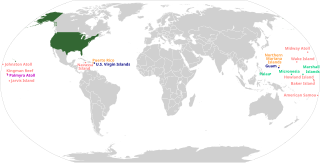
The 51st state in American political discourse refers to the concept of granting statehood to one of the United States' territories, splitting one or more of the existing states up to form a new state, or granting statehood to the District of Columbia, thereby increasing the number of states in the Union from 50 to 51.

The Territory of Hawaii or Hawaii Territory was an organized incorporated territory of the United States that existed from April 30, 1900, until August 21, 1959, when most of its territory, excluding Palmyra Island, was admitted to the United States as the 50th U.S. state, the State of Hawaii. The Hawaii Admission Act specified that the State of Hawaii would not include Palmyra Island, the Midway Islands, Kingman Reef, and Johnston Atoll, which includes Johnston Island and Sand Island.
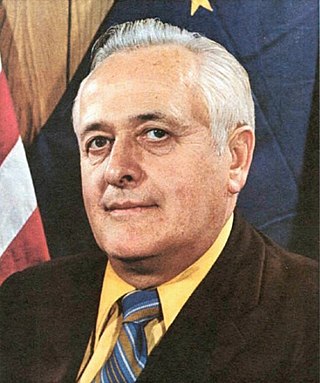
William Allen Egan was an American Democratic politician. He served as the first governor of the State of Alaska from January 3, 1959, to 1966 and 1970 to 1974, as well as a shadow U.S. Senator from Alaska Territory from 1956 to 1959. Born in Valdez, Alaska, Egan is one of only two governors in the state's history to have been born in Alaska. He was the Democratic nominee in the first five gubernatorial elections.
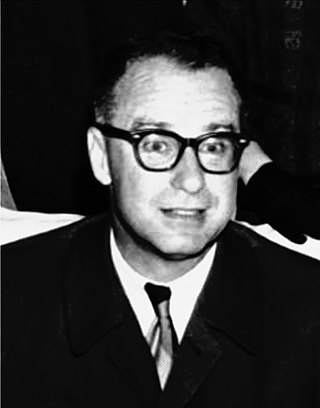
William Francis QuinnOESSH was an American lawyer and politician who served as the 12th and last governor of the Territory of Hawaii from 1957 to 1959 and the first governor of the State of Hawaii from 1959 to 1962. Originally appointed to the office by President Dwight D. Eisenhower, Quinn was the last executive appointed by an American president, after American rule of the Hawaiian Islands began after the overthrow of the monarchy in 1893. He was also the last Republican to serve as governor until Linda Lingle in 2002. Quinn appeared as a guest on the television program What's My Line. He was the recipient of the Order of the Holy Sepulchre, a papal knighthood conferred by Pope John Paul II.

Nelson Kiyoshi Doi, was the sixth lieutenant governor of Hawaii from 1974 to 1978 in the first elected administration of Governor George Ariyoshi. Doi was a member of the Hawaii Democratic Party.

James Kimo Kealoha was an American politician who served as the first lieutenant governor of Hawaii in the administration of Governor of Hawaiʻi William F. Quinn. Prior to his election as Lieutenant Governor, Kealoha served a number of years as a legislator on Hawaii island, distinguishing himself as a respected leader.

The Admission Act, formally An Act to Provide for the Admission of the State of Hawaii into the Union is a statute enacted by the United States Congress and signed into law by President Dwight D. Eisenhower which dissolved the Territory of Hawaii and established the State of Hawaii as the 50th state to be admitted into the Union. Statehood became effective on August 21, 1959. Hawaii remains the most recent state to join the United States.

The Great Seal of the State of Hawaii was designated officially by Act 272 of the 1959 Territorial Legislature and is based on the territorial seal. Modifications to the territorial seal included the use of the words "State of Hawaii" at the top and "1959" within the circle. Provisions for a seal for the state of Hawaii were enacted by the Territorial Legislature and approved by Governor William F. Quinn on June 8, 1959. The passage of the Admission Act in 1959, admitted Hawaii as the 50th State of the United States of America on August 21, 1959.

The Hawaii Republican Party is the affiliate of the Republican Party (GOP) in Hawaii, headquartered in Honolulu. The party was initially strong during Hawaii's territorial days, but following statehood the Democratic Party has become the dominant party in Hawaii. The party currently has very weak electoral power in the state and is one of the weakest affiliates of the national Republican Party; it currently controls none of Hawaii's statewide or federal elected offices.

The Puerto Rico statehood movement aims to make Puerto Rico a state of the United States. Puerto Rico is an unincorporated territorial possession of the United States acquired in 1898 following the Spanish–American War, making it "the oldest colony in the modern world". As of 2019, the population of Puerto Rico is 3.2 million, around half the average state population and higher than that of 20 U.S. states. Statehood is one of several competing options for the future political status of Puerto Rico, including: maintaining its current status, becoming fully independent, or becoming a freely associated state. Puerto Rico has held six referendums on the topic. These are non-binding, as the power to grant statehood lies with the US Congress. The most recent referendum was in November 2020, with a majority (52.52%) of those who voted opting for statehood.

The 2014 Illinois gubernatorial election was held on November 4, 2014, to elect the Governor and Lieutenant Governor of Illinois, concurrently with the election to Illinois's Class II U.S. Senate seat, as well as other elections to the United States Senate in other states and elections to the United States House of Representatives and various state and local elections.

The 1962 Hawaii gubernatorial election was Hawaii's second gubernatorial election. The election was held on November 6, 1962, and resulted in a victory for the Democratic candidate, former Territorial Delegate John A. Burns over Republican William F. Quinn, the incumbent Governor of Hawaii. The election was a rematch between the candidates of the previous election, with the outcome reversed. Burns received more votes than Quinn in every county in the state.

The 1959 United States Senate elections in Hawaii were held July 28, 1959. Following the admission of Hawaii as the fiftieth State in the union, the state held two simultaneous elections to determine their first senators.
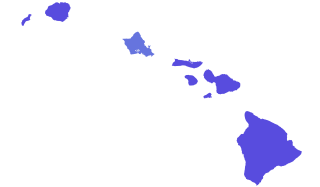
The 2018 Hawaii gubernatorial election took place on November 6, 2018, to elect the Governor of Hawaii and Lieutenant Governor of Hawaii.

Nancy Ellen Quinn was an American public figure, former First Lady of Hawaii, and a prominent figure during Hawaii's transition to statehood. Quinn, the wife of Governor William F. Quinn, served as the last First Lady of the Territory of Hawaii from 1957 until 1959. She then served as the first First Lady of the new U.S. state of Hawaii from 1959 to 1962. According to Time Magazine, Nancy Quinn was the first person in the Territory of Hawaii to receive news that the bill granting Hawaiian statehood had been signed by President Dwight Eisenhower in 1959.

Beatrice Majors Van Vleet Burns was the First Lady of Hawaii for three terms. Born in Oregon and raised in numerous states, she became a registered nurse, joined the United States Army Nurse Corps, and moved to Hawaii. She met Hawaii's future governor John A. Burns during a picnic at Hanauma Bay, when he was a college student. Together they had four children, one of whom was born premature and died when she was struck by poliomyelitis. She never fully recovered from her paralysis, but lived a full life as a wife and mother. While First Lady of Hawaii, she restored the governor's residence of Washington Place.
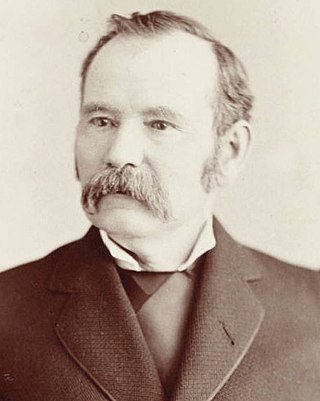
The 1876 Colorado gubernatorial election took place on October 3, 1876, to elect the 1st Governor of Colorado after the state was admitted to the union on August 1, 1876. Republican John Long Routt, last governor of the Colorado Territory, was elected in a close race against Democratic nominee Bela M. Hughes.
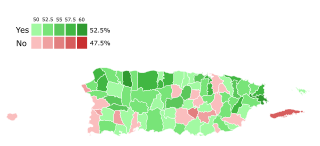
A referendum of the status of Puerto Rico was held on November 3, 2020, concurrently with the general election. The Referendum was announced by Puerto Rico Governor Wanda Vázquez Garced on May 16, 2020. This was the sixth referendum held on the status of Puerto Rico, with the previous one having taken place in 2017. This was the first referendum with a simple yes-or-no question, with voters having the option of voting for or against becoming a U.S. state. The New Progressive Party (PNP), of whom Vázquez is a member, supports statehood, while the opposition Popular Democratic Party (PDP) and Puerto Rican Independence Party (PIP) oppose it.




















